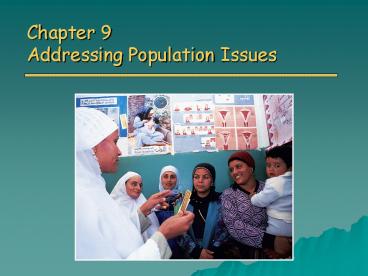Chapter 9 Addressing Population Issues - PowerPoint PPT Presentation
1 / 21
Title:
Chapter 9 Addressing Population Issues
Description:
Rapidly expanding hampers developmental efforts. Most observations support ... Developmental efforts are also hampered by debt from past development attempts ... – PowerPoint PPT presentation
Number of Views:45
Avg rating:3.0/5.0
Title: Chapter 9 Addressing Population Issues
1
Chapter 9Addressing Population Issues
2
Overview of Chapter 9
- Population and Quality of Life
- Population and Chronic Hunger
- Economic Effects of Population Growth
- Reducing the Total Fertility Rate
- Culture and Fertility
- Social and Economic Status of Women
- Family Planning Services
- Government Policies and Fertility
- China, India, Mexico, Nigeria, Europe
- Achieving Population Stabilization
3
Population and Quality of Life
- Difficult to meet basic needs in developing
countries - Problems associated with overpopulation
- Environmental degradation
- Hunger
- Persistent poverty
- Economic stagnation
- Urban deterioration
- Health issues
4
Carrying Capacity
- Carrying Capacity (K)
- The maximum number of individuals of a given
species that a particular environment can support
for an indefinite period, assuming no changes in
the environment - Overuse of land can cause a decrease in carrying
capacity - Uncertain what the carrying capacity of the earth
is for humans
5
Population and Chronic Hunger
- Food security
- Condition in which people live with chronic
hunger and malnutrition - Effects of Chronic Hunger
- Weakened immune system
- Illness and disease
- Malaria
- Measles
- Diarrhea
- Acute respiratory illness
6
Population and Chronic Hunger
- Solving the Food Problem
- Control population growth
- Promote economic development of developing
countries without adequate food supplies - Provide assess to food and land resources to
those who live in areas without them
7
(No Transcript)
8
Economic Effects of Population Growth
- Two viewpoints from economists
- Population growth stimulates economic development
and technological innovation - Rapidly expanding hampers developmental efforts
- Most observations support the second viewpoint
- Developmental efforts are also hampered by debt
from past development attempts
9
Reducing the Total Fertility Rate
- Three major influences on total fertility rate
- Cultural traditions
- Social economic status of women
- Family planning
10
Cultural Traditions
- Culture influences and controls individuals
behaviors - Marriage age
- Couple is expected to have large number of
children - Due to high infant and child mortality rates
- Children often work in family business
- Provide support for aging parents
- Religious values
11
Social Economic Status of Women
- Gender inequality is common worldwide
- Disparities
- Political participation
- Social status
- Economic status
- Health status
- Legal rights
- Education
- Employment and
- earnings
Illiteracy in 2002
Single most important factor affecting high total
fertility rates is low status of women
12
Educational Opportunities and Fertility
- Women with more education
- Marry later
- Have fewer children
13
Family Planning Services
- In many countries men make reproductive decisions
regarding contraceptives - Family planning services offer information to
both men and women on - Sexuality
- Contraception
- STDs
- Parenting
14
Contraceptive Use Among Married Women of
Reproductive Age
15
Government Policies and Fertility- China
- Largest population in the world
- Controversial Family Planning Policy
- 1971- Chinese Government pursued birth control
seriously - 1979- Incentives to promote later marriages and
one-child families - Medical care, schooling for child, preferential
housing, retirement funds - Brought about rapid and drastic decrease in
fertility
16
Government Policies and Fertility- China
- Law controversial and unpopular
- Compromised freedom of choice
- Social pressure to abort a second child
- Pressure to abort/kill female first child
- More boys than girls in China
- Law more relaxed in rural China
17
Government Policy and Fertility- India
- Severe population pressure
- 1950- first country with government-sponsored
family planning - Did not work due to language/cultural barriers
- 1976- introduced incentives and compulsory
sterilization - Unpopular and failure
- Recent years- government focused on education
- Much more effective, but TFR still above
replacement level
18
Government Policy and Fertility- Mexico
- Young age structure
- Huge potential for population growth 33 of
population is under age 15 - Positive growth momentum
- 1974- government imparted educational reform,
family planning, health care - Very successful
19
Government Policy and Fertility- Nigeria
- Population challenge
- Largest population of any African country
- Very high reproductive potential 43 of
population is less than age 15 - Current National Population Policy
- Improving health care
- Population education
20
Government Policy and Fertility- Europe
- Population concern
- Proportion elderly people in population is
increasing - Due to low TFR
- Decrease in population could cause decrease
economic growth
21
Achieving Population Stabilization
- How can developing country governments help?
- Increase allotted to pubic health and family
planning services - Education on affordable, safe, effective methods
of birth control - Increase average level of education
- Especially for women
- How can developed country governments help?
- Provide financial support
- Supporting research and development of new birth
control methods































